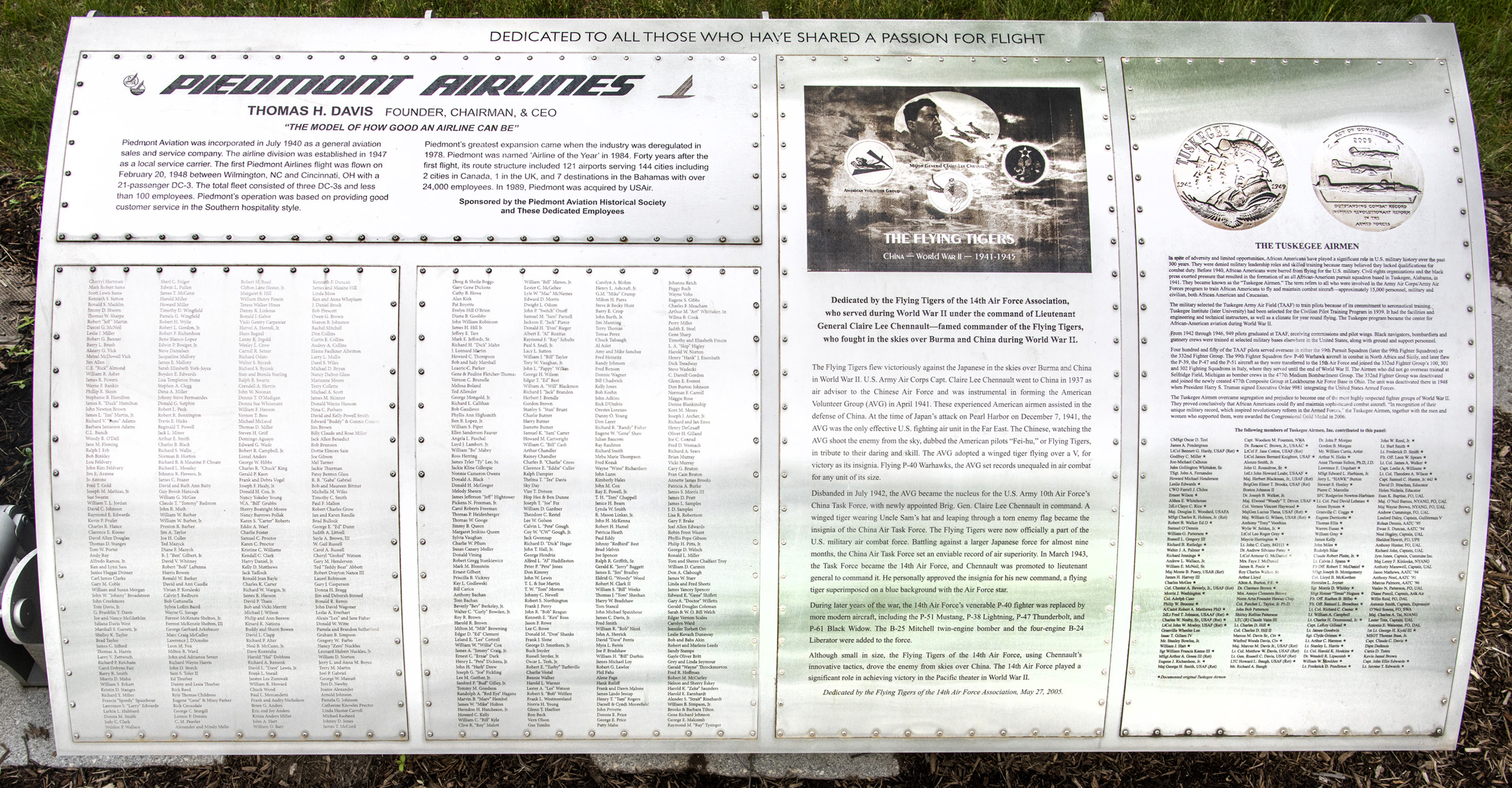Foil: 12 Panel: Tuskegee Airmen Column: 1 Line: 27
Wall of Honor Level: Air and Space Friend
Honored by:
The following was written by Col Charles E. McGee, USAF (Ret).
I had the tremendous experience of training and fighting in World War II as a Tuskegee Airman, one of a tight knit group of African American fighter pilots who broke down racial barriers as they helped defeat the German Luftwaffe.
The P51-C Mustang fighter was a signature aircraft for the Tuskegee Airmen. We painted our Mustangs' tails red so the Germans knew who they were dealing with! The bomber pilots we protected - all of whom were white - called us the "Red Tail Angels."
The following is a quick look back at history.
The Tuskegee Airmen, along with millions of other Americans, fought heroically to defeat Hitler's Germany.
But the Airmen really fought two wars - one against the Nazis overseas, the other against segregation in the Armed Services as well as in everyday life.
At the time of the war, the idea of an all African American flight squadron was radical and offensive to many. The prevailing opinion was that blacks did not possess the intelligence or courage to be military pilots. One general even wrote, "The Negro type has not the proper reflexes to make a first-rate fighter pilot." The Tuskegee Airmen certainly proved men like him wrong. Very few bombers were lost on our watch, and 251 enemy aircraft were shot down.
The extraordinary success of the Tuskegee Airmen in World War II led to the integration of the Armed Forces by Harry Truman in 1948. Certainly, much of the success of the Tuskegee Airmen is the result of the leadership of Benjamin O. Davis, who would later become a four-star general in the Air Force. Benjamin Davis was the first African American graduate of West Point in the 20th Century. As the son of an Army officer, he had hoped his fellow cadets would judge him based on character and not his race. But instead, he was "shunned" at West Point, which meant he had no roommates and was spoken to only for official reasons.
In 1942, Benjamin Davis was selected to train as a fighter pilot at the Tuskegee Institute in Alabama and was in the first graduating class. He was soon named squadron commander. Some believe the intent of setting up the Tuskegee Institute to train black pilots was to show that they didn't have the intelligence or talent to fly. But if that was the intent, it backfired. Benjamin Davis' leadership instilled pride and discipline in his Tuskegee pilots that resulted in our success in combat against the Luftwaffe.
During training, Davis focused on setting goals and working together to attain them. Unlike some commanders who allowed fighter pilots to pursue enemy aircraft far and wide to get "kills," Davis put a premium on fighters staying relatively close to the bombers. This tactic led to the Tuskegee Airmen's success in defending bombers - even against the much faster German Messerschmitts -- and helped shorten the war. The Tuskegee Airmen's success in safely escorting their men home was a well-known fact. When a bomber squadron commander asked why he asked for the "Red Tails," as we were known, to escort his unit, he said, "I want my boys to get home." And they did.
The "Red Tails" were so successful, in fact, that many refused to believe we were African American.
In over 15,000 combat missions, 66 Tuskegee Airmen died in combat; 32 became POWs. They also earned hundreds of awards including 150 Distinguished Flying Crosses, 8 Purple Hearts, and 14 Bronze Stars.
The Tuskegee Airmen did not return to a hero's welcome, though. Pilot Joe Gomer said, "We didn't come back as combat veterans, we came back as second-class citizens. German POWs were treated better." We were often denied basic privileges given to other officers, such as the right to go to an Officer's Club. But our record of bravery in adverse conditions played a major role in ending segregation and bringing about social change in America.
Like you, I am pleased that America has put segregation and other forms of racial discrimination behind us. But I am bothered that so few young people understand World War II history, including the unique contribution of the Tuskegee Airmen. It's important for our young people to not only know where our country is going, but also where it's been. And, in the case of the Tuskegee Airmen, their hope of being allowed to fly and fight for their country, their goal of training to be the best fighter pilots while overcoming unbelievable odds, and their example still ring true today.
I am often asked why the Tuskegee Airmen were so successful in combat. I would say it was because of our courage and perseverance. We dreamed of being pilots as boys but were told it was not possible. Through faith and determination we overcame enormous obstacles. This is a lesson that all young people need to hear.
I am most proud of my work as a Tuskegee Airman that helped bring down racial barriers and defeat the Nazis. I hope you agree that the Tuskegee Airmen deserve special recognition.
Wall of Honor profiles are provided by the honoree or the donor who added their name to the Wall of Honor. The Museum cannot validate all facts contained in the profiles.
Foil: 12
All foil images coming soon.View other foils on our Wall of Honor Flickr Gallery
